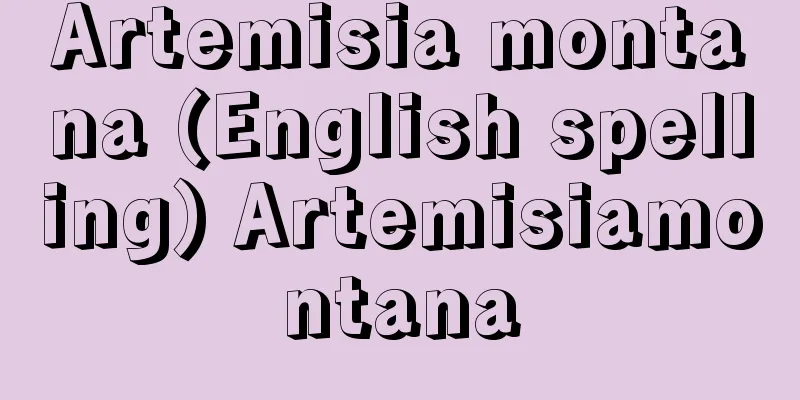Kagura

〘Noun〙 (A variation of " kamukura" ) 1. Bugaku dance performed before the altar to worship the gods. Its form was refined during the Heian period. Three instruments were used - the wagon , Yamato flute, and shakubyoshi - but later the hichiriki was added. The musicians are divided into two seats on the left and right sides of the garden, the mokata and suekata , and sing kagura songs and play instruments. The dancers perform dances, with the ninjo holding gifts such as sakaki branches, mitegura offerings , and walking sticks . The most representative example is the mikagura dance held at the Naishidokoro in December, and other Shinto festivals for the nobility were also held at night with niwabi lit in the garden . Kamiasobi (playing with the gods) . Season: Winter *Kogo Shūi (807) "Sarume no Kimi-shi offers to perform the Kagura dance" *Utsubo (c. 970-999) Saga-in "Thus, when November came, the Emperor was asked to perform the Kagura dance" ② Performing arts performed by various shrines and among the general public. Namely, Miko Kagura, in which shrine maidens dance; Sato Kagura and Daidai Kagura, in which myths and legends are performed as silent or spoken plays ; Yutate Kagura, in which purifying water is sprinkled; and Shishi Kagura, in which each household spins a lion's head and prays for good health and long life. Season: Winter *Haikai Kebukusō (1638) 2 "Mid-winter (abbreviated ) Kagura Sato Kagura " ③ The name of a type of Noh dance and the instrumental music that accompanies it. It is a dance in which actors playing the roles of gods, heavenly maidens, shrine maidens, etc. imitate the Miko Kagura. It is mainly the shite, but sometimes the tsure also dances. *Sando (1423) "Imitation human body items, heavenly maidens, shrine maidens, maidens - these are the dances and songs of Kagura." 4. Kyogen music and dance. The shrine maidens dance holding bells and fans, and it is accompanied by a flute and small drum. It is different from Noh Kagura, and has a prayerful atmosphere and a folk performing arts flavor. It is used in "Ishigami," "Taikobu," and "Daihannya." 5. One of the musical instruments used in Kabuki. It was transferred from Noh music to Kabuki geza music, and is played with Noh flutes, drums, and large drums. *Kabuki: Korean Chinese Texts, The Beginning of the Chinese (1789), vol. 1 "He became a Kagura dancer, and, accompanied by the priest and servants, entered the torii well." ⑥ A second story added on top of a single- story house. Okagura. [Tokyo Language Dictionary (1917)] ⑦ A face resembling a ghost. Also, that person. [Tokyo Language Dictionary (1917)] ⑧ One of the cultivated varieties of cotton that have been cultivated in Japan since ancient times. It is a species of Asian cotton native to the Orient, and refers to cotton with yellow or white flowers. Kagura cotton. *Comprehensive Agriculture Book (1697), vol. 6 "Cotton is, abbreviated: among the various colors of its seeds, the white-flowered kagura and the yellow-flowered kagura are excellent seeds."Kagura (Sacred Dance)Source: The Selected Edition of the Japanese Language Dictionary About the Selected Edition of the Japanese Language Dictionary Information |
〘名〙 (「神座(かむくら)」の変化した語)① 神をまつるために神前に奏する舞楽。平安時代にその形が整えられた。楽器は和琴(わごん)、大和笛、笏拍子(しゃくびょうし)の三つを用いたが、のちに篳篥(ひちりき)が加わった。楽人は庭上の左右に本方(もとかた)、末方(すえかた)の座に分かれ、神楽歌をうたい楽器を奏する。舞人が舞を舞うが、人長(にんじょう)は、榊(さかき)、幣(みてぐら)、杖(つえ)などの採物(とりもの)を持って舞う。一二月に行なわれた内侍所(ないしどころ)の御神楽(みかぐら)が最も代表的なもので、その他、貴族の神祭にも夜、庭燎(にわび)をたいて行なわれた。神遊(かみあそび)。《季・冬》※古語拾遺(807)「猿女君氏、神楽(かぐら)の事を供(たてまつ)る」※宇津保(970‐999頃)嵯峨院「かくて、十一月になりて、御かぐらし給ふべきまうけし給ふ」② 諸社、民間に行なわれる芸能。すなわち、巫女が舞う巫女神楽、神話・伝説を黙劇または科白劇で演じる里神楽・太太神楽(だいだいかぐら)、清めの湯をふりかける湯立神楽、家ごとに獅子頭をまわし息災延命を祈る獅子神楽など。《季・冬》※俳諧・毛吹草(1638)二「中冬〈略〉神楽里神楽」③ 能の舞の一種、およびその伴奏の器楽の名。神、天女、巫女などの役の者が巫女神楽にまねて舞うもの。主としてシテが、また、時としてツレも舞う。※三道(1423)「物まねの人体の品々、天女・神女・乙女、是、神楽の舞歌也」④ 狂言の囃子と舞。巫女が鈴と扇を持って舞うもので、笛、小鼓で演奏する。能の神楽とは別物で、祈祷の気分を持ち、民俗芸能的な味わいをも感じさせる。「石神」「太鼓負」「大般若」で用いられる。⑤ 歌舞伎の囃子鳴り物の一つ。能の囃子から歌舞伎の下座(げざ)音楽に移されたもので、能管、太鼓、大太鼓ではやす。※歌舞伎・韓人漢文手管始(唐人殺し)(1789)一「ト神楽に成り、〈略〉神主・仕丁を連れ、鳥井の内へ這入」⑥ 平屋(ひらや)の上へ二階を建て増したもの。おかぐら。〔東京語辞典(1917)〕⑦ ひょっとこのような顔。また、その人。〔東京語辞典(1917)〕⑧ 古来日本で栽培されていたワタの栽培品種の一つ。東洋の在来種であるアジアワタで、花色が黄色または白色のものをいう。神楽綿。※農業全書(1697)六「木綿は〈略〉其たね色色ある中に、白花のかぐら、黄花のかぐら、是すぐれたるたねなり」
かみ‐がく【神楽】出典 精選版 日本国語大辞典精選版 日本国語大辞典について 情報 |
Recommend
River sand - Kawazuna
Sand collected from riverbeds, deltas, river mouth...
Shop system
A system in which a labor union and an employer o...
Stratovolcano (English spelling)
A volcano formed by alternating deposition of lava...
Perun
…Veles was the god of livestock. Perun, the thund...
Machaerotidae
...A general term for insects belonging to the He...
Paradox - Paradox (English spelling)
Suppose a proposition and its negation are assert...
Complex
A set K of at most countably many simplices of var...
Ems [river] - Ems
It originates in the mountains of Westphalia, Germ...
gable
…In the main nave, rectangular quarter vaults are...
Li Shizeng - Li Shizeng
Chinese scholar and politician. A senior member of...
Koto Yoka - Koto Yoka
It refers to the 8th of February and December. In ...
Kaiser Mountains
From the town, you can take a cable car up to the...
Java Sea - Laut Djawa
The area is surrounded by islands such as Indones...
Old - Old
It is a county-level city in the southeastern par...
vihuela
...Instrumental music also saw a remarkable rise,...

![Atami [city] - Atami](/upload/images/67cad4e5deb53.webp)







